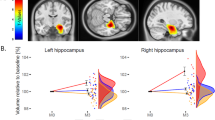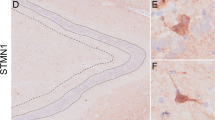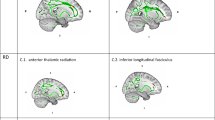Abstract
Electroconvulsive therapy (ECT) induces hippocampal volume increases in depressed patients, potentially reflecting neuroplasticity. We hypothesized that Neurite Orientation Dispersion and Density Imaging (NODDI) could provide in vivo evidence of hippocampal neuroplasticity following ECT. This longitudinal study evaluated 43 depressed patients undergoing ECT and 24 controls. MRI and clinical assessments were performed at baseline (V1), after 5 sessions (V2), and post-treatment (V3). Evaluations included a 3 T MR-scan with 3DT1-weighted and multi-shell diffusion (b = 200/1500/2500 s/mm², 30/45/60directions) sequences. Q-ball, Diffusion Tensor, and NODDI models provided: axial diffusivity (AD), radial diffusivity (RD), mean diffusivity (MD), fractional anisotropy (FA), generalized FA (GFA), neurite density index (NDI), isotropic fraction (Fiso), and orientation dispersion index (ODI). FreeSurfer extracted whole hippocampal and subfield volumes from T1-weighted images. Longitudinal changes were assessed with linear mixed-effect models. 107 MRIs from patients and 24 MRIs from controls were analyzed. ECT induced significant bilateral hippocampal volume increases (p < 0.001). Group comparisons showed consistently higher FA, lower GFA and ODI in patients compared to controls at all time-points. Following ECT, significant diffusion changes included decreased hippocampal GFA, FA, AD, MD and Fiso, along with increased ODI and NDI. NDI and Fiso changes were localized to the dentate gyrus but not the hippocampal tail. ECT responders showed a significant right hippocampal volume increase at V2 compared to non-responders. After ECT, hippocampal volume increases are accompanied by bilateral changes in NODDI parameters, particularly in the dentate gyrus, consistent with hippocampal neuroplasticity.
This is a preview of subscription content, access via your institution
Access options
Subscribe to this journal
Receive 12 print issues and online access
$259.00 per year
only $21.58 per issue
Buy this article
- Purchase on SpringerLink
- Instant access to full article PDF
Prices may be subject to local taxes which are calculated during checkout





Similar content being viewed by others
Data availability
The dataset analyzed during the current study are not publicly available but are available from the corresponding author upon motivated request.
References
GBD 2019 Mental Disorders Collaborators. Global, regional, and national burden of 12 mental disorders in 204 countries and territories, 1990–2019: a systematic analysis for the Global Burden of Disease Study 2019. Lancet Psychiatry. 2022;9:137–50.
Sinyor M, Schaffer A, Levitt A. The sequenced treatment alternatives to relieve depression (STAR*D) trial: a review. Can J Psychiatry Rev Can Psychiatr. 2010;55:126–35.
UK ECT Review Group. Efficacy and safety of electroconvulsive therapy in depressive disorders: a systematic review and meta-analysis. Lancet Lond Engl. 2003;361:799–808.
Loo CK, Garfield JBB, Katalinic N, Schweitzer I, Hadzi-Pavlovic D. Speed of response in ultrabrief and brief pulse width right unilateral ECT. Int J Neuropsychopharmacol. 2013;16:755–61.
Kaster TS, Vigod SN, Gomes T, Sutradhar R, Wijeysundera DN, Blumberger DM. Risk of serious medical events in patients with depression treated with electroconvulsive therapy: a propensity score-matched, retrospective cohort study. Lancet Psychiatry. 2021;8:686–95.
Perera TD, Coplan JD, Lisanby SH, Lipira CM, Arif M, Carpio C, et al. Antidepressant-induced neurogenesis in the hippocampus of adult nonhuman primates. J Neurosci Off J Soc Neurosci. 2 mai. 2007;27:4894–901.
Smitha JSM, Roopa R, Khaleel N, Kutty BM, Andrade C. Images in electroconvulsive therapy: electroconvulsive shocks dose-dependently increase dendritic arborization in the CA1 region of the rat hippocampus. J ECT. 2014;30:191–2.
Belleau EL, Treadway MT, Pizzagalli DA. The impact of stress and major depressive disorder on hippocampal and medial prefrontal cortex morphology. Biol Psychiatry. 2019;85:443–53.
Schmaal L, Veltman DJ, van Erp TGM, Sämann PG, Frodl T, Jahanshad N, et al. Subcortical brain alterations in major depressive disorder: findings from the ENIGMA Major Depressive Disorder working group. Mol Psychiatry. 2016;21:806–12.
Gryglewski G, Lanzenberger R, Silberbauer LR, Pacher D, Kasper S, Rupprecht R, et al. Meta-analysis of brain structural changes after electroconvulsive therapy in depression. Brain Stimulat. 2021;14:927–37.
Oltedal L, Narr KL, Abbott C, Anand A, Argyelan M, Bartsch H, et al. Volume of the human hippocampus and clinical response following electroconvulsive therapy. Biol Psychiatry. 2018;84:574–81.
Nuninga JO, Mandl RCW, Boks MP, Bakker S, Somers M, Heringa SM, et al. Volume increase in the dentate gyrus after electroconvulsive therapy in depressed patients as measured with 7T. Mol Psychiatry. 2020;25:1559–68.
Loef D, Tendolkar I, van Eijndhoven PFP, Hoozemans JJM, Oudega ML, Rozemuller AJM, et al. Electroconvulsive therapy is associated with increased immunoreactivity of neuroplasticity markers in the hippocampus of depressed patients. Transl Psychiatry. 2023;13:1–11.
Xie XH, Xu SX, Yao L, Chen MM, Zhang H, Wang C, et al. Altered in vivo early neurogenesis traits in patients with depression: Evidence from neuron-derived extracellular vesicles and electroconvulsive therapy. Brain Stimul Basic Transl Clin Res Neuromodulation. 2024;17:19–28.
Pasternak O, Sochen N, Gur Y, Intrator N, Assaf Y. Free water elimination and mapping from diffusion MRI. Magn Reson Med. 2009;62:717–30.
Assaf Y. Imaging laminar structures in the gray matter with diffusion MRI. NeuroImage. 2019;197:677–88.
Kim H, Shon SH, Joo SW, Yoon W, Lee JH, Hur JW, et al. Gray matter microstructural abnormalities and working memory deficits in individuals with Schizophrenia. Psychiatry Investig. 2019;16:234–43.
Lee JS, Kim CY, Joo YH, Newell D, Bouix S, Shenton ME, et al. Increased diffusivity in gray matter in recent onset schizophrenia is associated with clinical symptoms and social cognition. Schizophr Res. 2016;176:144–50.
Zhang H, Schneider T, Wheeler-Kingshott CA, Alexander DC. NODDI: practical in vivo neurite orientation dispersion and density imaging of the human brain. NeuroImage. 2012;61:1000–16.
Nazeri A, Schifani C, Anderson JAE, Ameis SH, Voineskos AN. In vivo imaging of gray matter microstructure in major psychiatric disorders: opportunities for clinical translation. Biol Psychiatry Cogn Neurosci Neuroimaging. 2020;5:855–64.
Sato K, Kerever A, Kamagata K, Tsuruta K, Irie R, Tagawa K, et al. Understanding microstructure of the brain by comparison of neurite orientation dispersion and density imaging (NODDI) with transparent mouse brain. Acta Radiol Open. 2017;6:2058460117703816.
Giachetti I, Padelli F, Aquino D, Garbelli R, De Santis D, Rossini L, et al. Role of NODDI in the MRI characterization of hippocampal abnormalities in temporal lobe epilepsy. Neurology. 2022;98:e1771–82.
Chau Loo Kung G, Chiu A, Davey Z, Mouchawar N, Carlson M, Moein Taghavi H, et al. High-resolution hippocampal diffusion tensor imaging of mesial temporal sclerosis in refractory epilepsy. Epilepsia. 2022;63:2301–11.
Lam HW, Patodia S, Zeicu C, Lim YM, Mrzyglod A, Scott C, et al. Quantitative cellular pathology of the amygdala in temporal lobe epilepsy and correlation with magnetic resonance imaging volumetry, tissue microstructure, and sudden unexpected death in epilepsy risk factors. Epilepsia. 2024;65:2368–85.
Ota M, Noda T, Sato N, Hidese S, Teraishi T, Setoyama S, et al. The use of diffusional kurtosis imaging and neurite orientation dispersion and density imaging of the brain in major depressive disorder. J Psychiatr Res. 2018;98:22–9.
Haykal S, Invernizzi A, Carvalho J, Jansonius NM, Cornelissen FW. Microstructural visual pathway white matter alterations in primary open-angle glaucoma: a neurite orientation dispersion and density imaging study. AJNR Am J Neuroradiol. 2022;43:756–63.
Villemonteix T, Guerreri M, Deantoni M, Balteau E, Schmidt C, Stee W, et al. Sleep-dependent structural neuroplasticity after a spatial navigation task: a diffusion imaging study. J Neurosci Res. 2023;101:1031–43.
Andersson JLR, Skare S, Ashburner J. How to correct susceptibility distortions in spin-echo echo-planar images: application to diffusion tensor imaging. NeuroImage. 2003;20:870–88.
Smith SM, Jenkinson M, Woolrich MW, Beckmann CF, Behrens TEJ, Johansen-Berg H, et al. Advances in functional and structural MR image analysis and implementation as FSL. NeuroImage. 2004;23:S208–219.
Descoteaux M, Angelino E, Fitzgibbons S, Deriche R. Regularized, fast, and robust analytical Q-ball imaging. Magn Reson Med. 2007;58:497–510.
Perrin M, Poupon C, Rieul B, Leroux P, Constantinesco A, Mangin JF, et al. Validation of q-ball imaging with a diffusion fibre-crossing phantom on a clinical scanner. Philos Trans R Soc B Biol Sci. 2005;360:881–91.
Fischl B. FreeSurfer. NeuroImage. 2012;62:774–81.
Sämann PG, Iglesias JE, Gutman B, Grotegerd D, Leenings R, Flint C, et al. FreeSurfer-based segmentation of hippocampal subfields: A review of methods and applications, with a novel quality control procedure for ENIGMA studies and other collaborative efforts. Hum Brain Mapp. 2022;43:207–33.
Argyelan M, Deng ZD, Ousdal OT, Oltedal L, Angulo B, Baradits M, et al. Electroconvulsive therapy-induced volumetric brain changes converge on a common causal circuit in depression. Mol Psychiatry. 20 nov 2023.
Gbyl K, Støttrup MM, Mitta Raghava J, Xue Jie S, Videbech P. Hippocampal volume and memory impairment after electroconvulsive therapy in patients with depression. Acta Psychiatr Scand. 2021;143:238–52.
Takamiya A, Chung JK, Liang KC, Graff-Guerrero A, Mimura M, Kishimoto T. Effect of electroconvulsive therapy on hippocampal and amygdala volumes: systematic review and meta-analysis. Br J Psychiatry J Ment Sci. 2018;212:19–26.
Wilkinson ST, Sanacora G, Bloch MH. Hippocampal volume changes following electroconvulsive therapy: a systematic review and meta-analysis. Biol Psychiatry Cogn Neurosci Neuroimaging. 2017;2:327–35.
Ousdal OT, Argyelan M, Narr KL, Abbott C, Wade B, Vandenbulcke M, et al. Brain changes induced by electroconvulsive therapy are broadly distributed. Biol Psychiatry. 2020;87:451–61.
Jorgensen A, Magnusson P, Hanson LG, Kirkegaard T, Benveniste H, Lee H, et al. Regional brain volumes, diffusivity, and metabolite changes after electroconvulsive therapy for severe depression. Acta Psychiatr Scand. 2016;133:154–64.
Yrondi A, Nemmi F, Billoux S, Giron A, Sporer M, Taib S, et al. Significant decrease in hippocampus and amygdala mean diffusivity in treatment-resistant depression patients who respond to electroconvulsive therapy. Front Psychiatry [Internet]. 2019 [cité 18 août 2022];10. Disponible sur: https://www.frontiersin.org/articles/10.3389/fpsyt.2019.00694.
Nuninga JO, Mandl RCW, Froeling M, Siero JCW, Somers M, Boks MP, et al. Vasogenic edema versus neuroplasticity as neural correlates of hippocampal volume increase following electroconvulsive therapy. Brain Stimulat. 2020;13:1080–6.
Wang Z, Zhang S, Liu C, Yao Y, Shi J, Zhang J, et al. A study of neurite orientation dispersion and density imaging in ischemic stroke. Magn Reson Imaging. 2019;57:28–33.
Batalle D, O’Muircheartaigh J, Makropoulos A, Kelly CJ, Dimitrova R, Hughes EJ, et al. Different patterns of cortical maturation before and after 38 weeks gestational age demonstrated by diffusion MRI in vivo. NeuroImage. 2019;185:764–75.
Yeh FC, Wedeen VJ, Tseng WY. Generalized q-sampling imaging. IEEE Trans Med Imaging. 2010;29:1626–35. https://pubmed.ncbi.nlm.nih.gov/20304721/.
Wu C, Jia L, Mu Q, Fang Z, Hamoudi HJAS, Huang M, et al. Altered hippocampal subfield volumes in major depressive disorder with and without anhedonia. BMC Psychiatry. 2023;23:540.
Holikova K, Selingerova I, Pospisil P, Bulik M, Hynkova L, Kolouskova I, et al. Hippocampal subfield volumetric changes after radiotherapy for brain metastases. Neuro-Oncol Adv. 2024;6:vdae040.
Abbott LC, Nigussie F. Adult neurogenesis in the mammalian dentate gyrus. Anat Histol Embryol. 2020;49:3–16.
Kempermann G, Song H, Gage FH. Neurogenesis in the Adult Hippocampus. Cold Spring Harb Perspect Biol. 2015;7:a018812.
Rao MS, Shetty AK. Efficacy of doublecortin as a marker to analyse the absolute number and dendritic growth of newly generated neurons in the adult dentate gyrus. Eur J Neurosci. 2004;19:234–46.
Imoto Y, Segi-Nishida E, Suzuki H, Kobayashi K. Rapid and stable changes in maturation-related phenotypes of the adult hippocampal neurons by electroconvulsive treatment. Mol Brain. 2017;10:8.
Zhou Y, Su Y, Li S, Kennedy BC, Zhang DY, Bond AM, et al. Molecular landscapes of human hippocampal immature neurons across lifespan. Nature. 2022;607:527–33.
Zhao C, Warner-Schmidt J, Duman RS, Gage FH. Electroconvulsive seizure promotes spine maturation in newborn dentate granule cells in adult rat. Dev Neurobiol. 2012;72:937–42.
Chen F, Madsen TM, Wegener G, Nyengaard JR. Repeated electroconvulsive seizures increase the total number of synapses in adult male rat hippocampus. Eur Neuropsychopharmacol J Eur Coll Neuropsychopharmacol. 2009;19:329–38.
De Jager JE, Boesjes R, Roelandt GHJ, Koliaki I, Sommer IEC, Schoevers RA, et al. Shared effects of electroconvulsive shocks and ketamine on neuroplasticity: a systematic review of animal models of depression. Neurosci Biobehav Rev. 2024;164:105796.
Abe Y, Erchinger VJ, Ousdal OT, Oltedal L, Tanaka KF, Takamiya A. Neurobiological mechanisms of electroconvulsive therapy for depression: insights into hippocampal volumetric increases from clinical and preclinical studies. J Neurochem. 2024;168:1738–50.
Kubicki A, Leaver AM, Vasavada M, Njau S, Wade B, Joshi SH, et al. Variations in hippocampal white matter diffusivity differentiate response to electroconvulsive therapy in major depression. Biol Psychiatry Cogn Neurosci Neuroimaging. 2019;4:300–9.
Gbyl K, Labanauskas V, Lundsgaard CC, Mathiassen A, Ryszczuk A, Siebner HR, et al. Electroconvulsive therapy disrupts functional connectivity between hippocampus and posterior default mode network. Prog Neuropsychopharmacol Biol Psychiatry. 2024;132:110981.
Nagin DS, Odgers CL. Group-Based trajectory modeling in clinical research. Annu Rev Clin Psychol. 2010;6:109–38.
Nguefack HLN, Pagé MG, Katz J, Choinière M, Vanasse A, Dorais M, et al. <p>Trajectory modelling techniques useful to epidemiological research: a comparative narrative review of approaches</p>. Clin Epidemiol. 2020;12:1205–22.
Nordanskog P, Larsson MR, Larsson EM, Johanson A. Hippocampal volume in relation to clinical and cognitive outcome after electroconvulsive therapy in depression. Acta Psychiatr Scand. 2014;129:303–11.
Takamiya A, Plitman E, Chung JK, Chakravarty M, Graff-Guerrero A, Mimura M, et al. Acute and long-term effects of electroconvulsive therapy on human dentate gyrus. Neuropsychopharmacology. 2019;44:1805–11.
Bouckaert F, Dols A, Emsell L, De Winter FL, Vansteelandt K, Claes L, et al. Relationship between hippocampal volume, serum BDNF, and depression severity following electroconvulsive therapy in late-life depression. Neuropsychopharmacol Off Publ Am Coll Neuropsychopharmacol. 2016;41:2741–8.
Acknowledgements
We thank the patients for their trust and commitment in making this clinical trial possible. We thank all the nursing and administrative staff who devoted time and effort to the success of this research project, in particular Bénédicte Launay-Saucet, the clinical trial nurse coordinator. The clinical trial was sponsored by the Groupe Hospitalier Universitaire Paris Psychiatrie et Neurosciences and its Delegation for Clinical Research and Innovation; we thank Viviane Awassi, Kenza Sabi, Khaoussou Sylla and Marin Chapelle. This work was supported and funded by the Groupe Hospitalier Universitaire Paris Psychiatrie et Neurosciences (‘Appel à projets 2017’) and the Fondation de France (‘AO 2017 sur les maladies psychiatriques’). We thank Denis David and Jean-Philippe Guilloux for fruitful discussions. Finally, we thank the reviewers for their significant contributions, which helped to improve this work.
Author information
Authors and Affiliations
Contributions
DA and MP contributed to the conception and design of the study. DA, MP, CD, SC, LM, PG, ML, CO contributed to clinical and MRI data acquisition. IU and CP provided methodological development. ALB, IU, CD, CP, AC, FR conducted MRI data preprocessing and statistical data analysis. ALB, DA, MP, AC, CO conducted the interpretation of the analyses with additional contributions from MM and AH. DA, MP, ML, CD, SC provided administrative, technical, and material support. ALB drafted the manuscript. CO, AC and MP supervised the study and critically revised the manuscript. All authors reviewed and approved the final version of the manuscript.
Corresponding author
Ethics declarations
Ethics declaration
All methods were performed in accordance with the relevant guidelines and regulations.
Competing interests
The authors declare no competing interests.
Additional information
Publisher’s note Springer Nature remains neutral with regard to jurisdictional claims in published maps and institutional affiliations.
Supplementary information
Rights and permissions
Springer Nature or its licensor (e.g. a society or other partner) holds exclusive rights to this article under a publishing agreement with the author(s) or other rightsholder(s); author self-archiving of the accepted manuscript version of this article is solely governed by the terms of such publishing agreement and applicable law.
About this article
Cite this article
Le Berre, A., Attali, D., Uszynski, I. et al. Hippocampal microstructural changes following electroconvulsive therapy in severe depression. Mol Psychiatry 30, 4343–4352 (2025). https://doi.org/10.1038/s41380-025-03016-x
Received:
Revised:
Accepted:
Published:
Issue date:
DOI: https://doi.org/10.1038/s41380-025-03016-x



